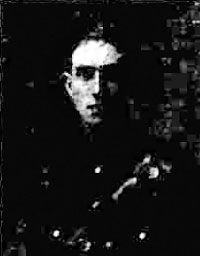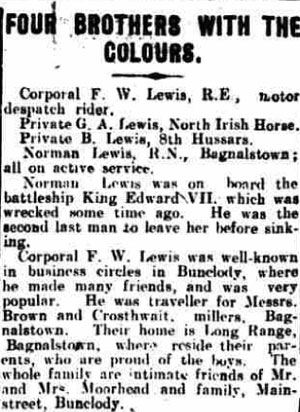Private George Alexander Lewis

George Alexander Lewis was born on 10 December 1894 at Long Range, Bagenalstown, County Carlow, the second of six children of petty sessions clerk Richard Lewis and his wife Lucy Wilson Lewis (née Hughes). By the time of the 1911 Census he and his younger brother Robert Henry were living as boarders at the Dublin Working Boys' Home & Harding Technical School in Lord Edward Street, Dublin, George working as a commercial clerk.
Lewis enlisted in the North Irish Horse between 22 and 24 May 1915 (No.1569). He trained at the regiment's Antrim reserve camp before embarking for France in 1916 or the first half of 1917, where he was posted to one of the squadrons of the 1st or 2nd North Irish Horse Regiments.
In August-September 1917 the 2nd NIH Regiment was disbanded and its men, together with some surplus to the needs of the 1st NIH Regiment, were transferred to the Royal Irish Fusiliers, an infantry regiment. Most, including Lewis, were transferred on 20 September and posted to the 9th (Service) Battalion – renamed the 9th (North Irish Horse) Battalion – joining it in the field at Ruyaulcourt five days later. Lewis was issued regimental number 41417 and posted to B Company.
He probably saw action with the battalion at the Battle of Cambrai in November and December 1917.
Lewis was one of the many posted as missing following the 9th (NIH) Battalion's fighting withdrawal from St Quentin from 21 to 28 March 1918 during the German spring offensive. It was later learned that he had been captured, unwounded, on 27 March at Erches, near Roye, when much of the battalion had been overwhelmed by the fast-moving German advance. He remained a prisoner until the end of the war, held at camps in Bohain, Giessen and Limburg.
Three of Lewis's five brothers also served in the war. Francis William Lewis, who served in France in the Royal Engineers and Royal Field Artillery from November 1914, was commissioned during the war and awarded a Military Cross for "cool courage and able leadership" on 10 August 1919 while serving with the Royal Field Artillery in Russia. He later qualified as a barrister and served as a district inspector of the Royal Ulster Constabulary.


Enniscorthy Guardian, 5 February 1916
